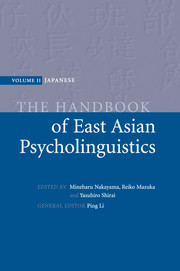Book contents
- Frontmatter
- Contents
- List of figures
- List of contributors
- In memory of Miwa Nishimura
- Preface
- Introduction
- Language acquisition
- 1 Ontogeny of language
- 2 Caregivers' speech
- 3 The intrinsic link between gesture and speech at the prelinguistic stage
- 4 Infant speech perception
- 5 Phonological acquisition
- 6 The mechanism of lexical development: implications from Japanese children's word learning
- 7 The acquisition of nouns and verbs in Japanese
- 8 The acquisition of verbal nouns
- 9 The acquisition of Japanese numeral classifiers
- 10 The acquisition of case markers
- 11 The acquisition of tense and aspect
- 12 On the origin of children's errors: the case of Japanese negation and direct passive
- 13 Binding Theory in UG and first-language acquisition of Japanese
- 14 The acquisition of the particles ne, yo, and no
- 15 The acquisition of linguistic politeness in Japanese
- 16 Children's narrative structures
- 17 Memory talk and testimony in children
- 18 Developmental dyslexia
- 19 Japanese Sign Language
- 20 The role of an innate acquisition device in second-language acquisition
- 21 Japanese, the grammar of reflexives, and second-language acquisition
- 22 Processes in L2 Japanese sentence production
- 23 The development of lexical competence among second-language readers
- 24 Reading in Japanese as a second language
- 25 Intrasentential code-switching in Japanese and English
- Part II Language processing
- References
- Name index
- Subject index
24 - Reading in Japanese as a second language
from Language acquisition
Published online by Cambridge University Press: 05 June 2012
- Frontmatter
- Contents
- List of figures
- List of contributors
- In memory of Miwa Nishimura
- Preface
- Introduction
- Language acquisition
- 1 Ontogeny of language
- 2 Caregivers' speech
- 3 The intrinsic link between gesture and speech at the prelinguistic stage
- 4 Infant speech perception
- 5 Phonological acquisition
- 6 The mechanism of lexical development: implications from Japanese children's word learning
- 7 The acquisition of nouns and verbs in Japanese
- 8 The acquisition of verbal nouns
- 9 The acquisition of Japanese numeral classifiers
- 10 The acquisition of case markers
- 11 The acquisition of tense and aspect
- 12 On the origin of children's errors: the case of Japanese negation and direct passive
- 13 Binding Theory in UG and first-language acquisition of Japanese
- 14 The acquisition of the particles ne, yo, and no
- 15 The acquisition of linguistic politeness in Japanese
- 16 Children's narrative structures
- 17 Memory talk and testimony in children
- 18 Developmental dyslexia
- 19 Japanese Sign Language
- 20 The role of an innate acquisition device in second-language acquisition
- 21 Japanese, the grammar of reflexives, and second-language acquisition
- 22 Processes in L2 Japanese sentence production
- 23 The development of lexical competence among second-language readers
- 24 Reading in Japanese as a second language
- 25 Intrasentential code-switching in Japanese and English
- Part II Language processing
- References
- Name index
- Subject index
Summary
Theoretical assumptions in L2 reading research
Only recently has research on reading in Japanese as a second language (JSL) started to appear in major journals in the fields of applied linguistics and second/foreign-language learning and teaching. Research on second-language (L2) reading has developed through the application of ideas from first-language (L1) reading research, mainly in English. Drawing on L1 models, L2 reading has been conceptualized as an active process in which the reader constructs meaning through interaction with a text, and a dynamic process in which bottom-up (text-based, data-driven) processing and top-down (knowledge-based, conceptually driven) processing take place interactively (Bernhardt, 1991; Swaffar, Arens, & Byrnes, 1991). Furthermore, this process is constrained by the available processing capacity.
Although there are currently a number of L1 reading models (e.g. Gernsbacher, 1994), most share the following assumptions about the cognitive process. The reader identifies letters and characters, recognizes words, and analyzes the syntactic and semantic relations in sentences to extract propositions. These propositions are integrated with information activated from general knowledge (i.e. inference) and encoded into a coherent representation of the text in memory. The resulting memory representation consists of multiple levels, including at least surface code, propositional text-base, and situation model (van Dijk & Kintsch, 1983). Throughout the course of processing a text, the reader monitors and regulates processing according to the comprehension goal in a given situation.
The differences between reading in the L1 and the L2
L1 reading research has a profound influence on L2 reading research. However, it is also important to note that, for all the underlying similarities between the two, L2 reading is different from L1 reading in a number of significant respects.
- Type
- Chapter
- Information
- The Handbook of East Asian Psycholinguistics , pp. 173 - 178Publisher: Cambridge University PressPrint publication year: 2006

